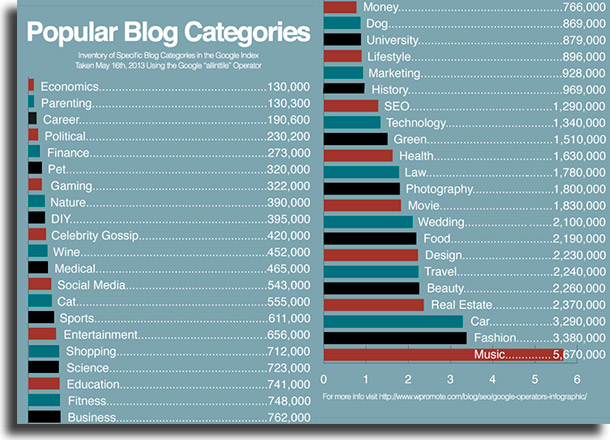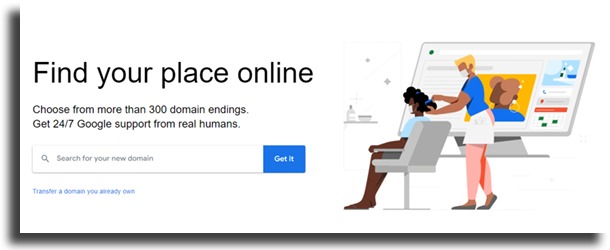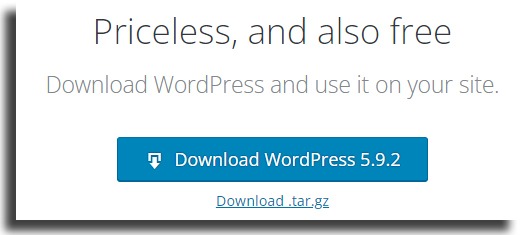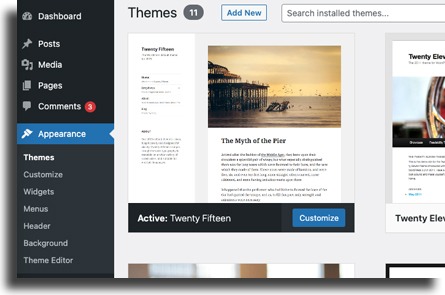If you want to know exactly how to do this, keep reading this guide and see all the necessary steps, plus some tips at the end!
1. Why should I create a blog?
One question you might be asking yourself is this. It’s important to know exactly why you’re doing this before learning how to create a blog. The many answers are listed below.
Having a blog gives you credibility
Something that successful blogs guarantee, that other media formats turn out to be weaker, is credibility and authority in the area your blog deals with. This is because the audience will read your content and interpret it as coming from an expert.
Having a blog helps in your business
If you have a business, whether it’s a physical store or e-commerce, or you’re even an influencer who wants to start selling products, creating a blog will help you a lot in your sales. For this, you need to focus on keeping the blog active, which will make readers loyal and create strong connections, something very important when the goal is to sell. Of course, your products must be of high quality, or else you will just push away future readers.
Having a blog gives you visibility
No matter how good your products are, if you don’t have visibility and aren’t found in searches, you’re not going to reach anyone and that’s another reason for you to create a blog. Creating a blog is an excellent way to have a good audience, especially if your content is of high quality. That being the case, people who read it will feel confident in recommending your blog to friends and acquaintances, which will serve to increase your traffic.
Having a blog can help YOU
Sometimes, it can also be very handy to elaborate your ideas when you are not naturally eloquent. If you have communication problems, knowing how to create a blog can be very good as this form of media tends to help a lot in communicating and writing better and helping your thinking ability. In addition, you also improve in doing online searches, since, for all content you are going to write, a research process will need to be done.
2. How to have a successful blog?
There are several ways that someone who wants to have a blog can do so. It can be in any field you want, on one of several platforms, created in various technologies, and written in any language. Traffic can be organic (which comes without your involvement), directed from social media platforms, and more. In order to achieve this goal, you need a concrete strategy, using the topics of this article, having well-written high-quality content, having a good design, and much more. So read on below and discover everything it takes to make a name for yourself with a blog!
3. Decide what your market will be
This part of the blogging process can be quite tricky given the myriad niche options you can choose from for your own blog. To decide which one is ideal for you, it is not enough to select one that has a smaller number of competitors. It is also necessary that your choice is one in which you feel comfortable not only writing about but also learning and studying it daily with ease. So, if you choose a topic that you don’t understand much or like very much, your blog is very likely to fail, because of how frustrating it will become. According to the study that generated the list below, carried out by Wpromote, these are the most popular categories for blogs. It’s easy to see that writing a music blog means you’ll have a lot more competitors, while a business blog will have a lot less.
However, keep in mind that the numbers vary greatly from country to country, and you need to really like what you’re writing.
4. Choose which platform you will use to create a blog
You can find a large number of platforms to create it, such as Blogger and WordPress (which has two versions). In addition to them, you can use Medium or LinkedIn Pulse, which are hybrid and less geared towards professional blogs.
Blogger: This is the oldest platform of its kind, created in 1999 and purchased by Google in 2003. To this day it is one of the biggest and best blogging platforms and is where newbies in the field tend to start, but ends up offering few options, being quite limiting. WordPress.com: It is currently the largest blogging platform in the world, being used by more than 43% of projects on the internet. However, it is a platform of its own, which ends up meaning that it is also quite limiting and complicates things if you want to scale up your blog. WordPress.org: Finally, we have the most recommended platform. In it, you will find the WordPress.com content manager to use with your own hosting. To use it, just download it, install it on a hosting server and create the contents. It is the best option for the long term.
Therefore, for those who want to create a successful blog that has a future, using WordPress.org is the best alternative. Even AppTuts itself is created with it!
5. Choose your blog domain
Before you can install WordPress on a hosting service, you need to know which domain you want to use. The domain is the name that your blog will have on the internet, added with some extension, such as “.info”, “.com”, “.net”, among others. Extensions are not all the same, nor do they serve the same purpose. For example, “.co.uk” is called a ccTLD (country code top-level domain), which means that all the websites that accompany it are associated with Brazil. International extensions, such as “.com”, “.net”, “.org”, are called gTLD (generic top-level domain). To use them, you need to determine in the search console which country you want to target your users. This means that your content will only be indexed in Google searches for that country. To find the right domain for you, you need to go to a site like domains.google to see if it’s available.
Choosing a good domain involves a few steps. The main thing is that you have a name that is easy to remember, that is simple. Avoiding using alliterations (two of the same letter together) is also recommended, and you should be careful about how the words look together. For example, “therapistfinder” is a bad choice, as the words can be read in a very different way. Focus on having a blog with a short, easy-to-write name. Creating a blog with a complex domain will alienate your readers because no one will want to write the whole name down (plus memorizing it is tricky). For example, “everythingabouttech.co.uk” is very complicated, but “techtoday.co.uk” is a good choice. Taking great care with trademarks is essential, not including names like Facebook, Google, Apple, or Microsoft in your domain.
6. Choose the hosting service
This is one of the most important aspects, as stable and secure hosting services are necessary for your blog to have constant high traffic without ever dropping, which results in the need for international hosting. Highly recommended for anyone looking to start a blog, Hostinger is one of the best options, being a highly reliable and already well-established company. It has a very low cost, with the cheapest plan costing only U$ 2.99 per month. See all about them on their website.
7. Install WordPress
With your domain purchased and hosting signed, you now need to install WordPress on the hosting server. To do this, it is highly recommended to use the one-click installation service, which will make your job a lot easier. If you prefer, you can also install it step by step, but this turns out to be quite complicated, not intuitive, and even impeding for those who do not have technical knowledge. To do so, follow the steps below.
First, download WordPress from the official website. Now, unzip the files using a program like WinRAR or 7-Zip. You will need to change the name of one of the files, wp-config-sample.php. Rename it to wp-config.php. Upload all extracted files to your hosting account via Cpanel in the public_html folder. In the Cpanel options, click on the “MySQL Database” option to create your database. Choose the name you want and write down the name because you will need to use it later. To be able to create a blog, it is necessary that you have a user to manage the database, choosing a strong password. Afterward, associate the user with the database and grant privileges to him. Go back to the folder where you originally extracted the files, open wp-config.php with notepad, and fill in the data correctly. Save it and upload it again, replacing the other file with the same name. Finally, just enter your domain to finish the blog creation process. It is recommended that you check the box that says “Prevent search engines from indexing this site” if you are just starting the blog, unchecking it when the blog is presentable.
8. Choose the theme for your website
On the left side of the WordPress dashboard, you can find all the navigation menus. There, go to “Appearance” and then to “Themes”. There, you can search through the layouts to find one that fits your blog.
You can refine your search in the “Feature Filter” menu, where you can define what types of themes you want. You can easily choose the default color, mode, and more. After selecting, the theme will be automatically applied to the blog. Now, just make all the settings to leave it exactly as you want.
9. Write great content
In the process of creating a blog, writing texts and content of the highest quality that are always relevant, is absolutely fundamental. If you don’t, no one will follow you. Above all, you need to know how to create new content, without always following what competing blogs are doing. After all, why would someone stop reading the blog they already follow to read yours, if the content is the same? Therefore, writing deep and enlightening texts is very good. However, it’s also good to keep an eye on what others are doing and, whenever you can, create even more complete articles. Finally, maintain consistency by always writing, for example, one new article a week, a new one a day, or some predetermined number. Without it, you will lose readers.
10. Choose a monetization model
After all, one of the main reasons to create a blog is to make extra income and work from home and over the internet. Therefore, making the choice of how to monetize your blog is important.
Indirect monetization
Indirect monetization takes place on personal and professional blogs. In this model, the intention is for you to be called to perform lectures or face-to-face training, for example. In general, income comes from sources outside your blog.
Direct monetization
In this model, which is the most common, it is necessary to work with affiliate programs or Google ads, in addition to some other options. This is particularly effective for article blogs, which work with other brands.
11. Final considerations
Here, we will cover some additional important points on how to create a blog.
Learn SEO: The first one is the need to learn SEO (Search Engine Optimization). In short, SEO is how your content is optimized for search services, in order to appear at the top of user searches, generating organic traffic; Determine your goals: It is important that you have concrete and realistic goals for your blog. For example, the number of visitors you receive, whether through organic, direct, or social media traffic; Have a newsletter: This is a good strategy to retain readers, as they will be notified by email when new articles are published on your blog so that they never forget you. It is good to offer options to receive emails daily or weekly, for example; Invest in the blog: If your goal is really to earn extra money, investments will be necessary to make the blog professional. Hiring a designer to make the logo, buying your own theme, and subscribing to marketing software are examples of possible investments.
So, what did you think of our complete guide on how to create a blog?
Leave your opinion about it in the comments, saying if we can help you in this process. Don’t forget to also check out our guides on how to make extra money at home and on what is Home Office!




